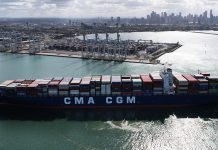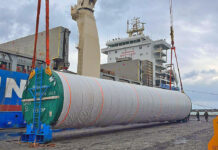
The total container ship capacity deployed on trades affected by the Red Sea crisis has increased by 1.26 million TEUs since October 2023, driven mainly by vessel diversions to the Cape of Good Hope, according to the latest Linerlytica report.
The Far East-Mediterranean recorded the largest jump of 610,000 TEUs, accounting for half of the increased capacity over the period, followed by the Far East-North Europe route at 260,000 TEUs.
“The increased demand for tonnage has fully absorbed all of the new capacity delivered in the last five months, with additional requirements for another 400,000 TEUs of incremental capacity still to be fulfilled,” said Linerlytica.
In the following graph, we observe the current container vessel fleet and the orderbook for the twelve major ocean carriers:

As per Alphaliner’s insights, the Swiss/Italian container giant MSC is expected to receive the highest number of boxships, followed by the French shipping company CMA CGM and Chinese ocean carrier COSCO. Taiwan’s major container line Evergreen has also made substantial orders for new container ships.
And amidst widespread speculation about the deployment of the latest additions to ocean carriers’ fleets, Red Sea developments underscore the imperative for preparedness in the dynamic landscape of the shipping industry.
Questions arose among industry experts regarding how shipping companies would utilize the significant influx of newbuildings, both those already received and those expected in the coming months. However, a swift answer presented itself with the emergence of another unforeseen event, demanding specialized operations.
But operating in anticipation of the next disruption is the new normal for shipping companies, according to Frank Kenney, director at Cleo, a supply chain connectivity and integration solution provider.
Kenney told Container News in an interview that “a major key learning [from the Ever Given incident in the Suez Canal] for organizations in the supply chain was the need for agility and visibility. While supply chain disruptions are inevitable, organizations learned they can prepare for any circumstances by investing in agile, modernized systems and strategies. By proactively anticipating change through traceable supply chains and forward-looking planning, companies have the power to identify innovative solutions that will keep operations running even during difficult times – helping them maintain business continuity no matter what comes their way.”
Kenney pointed out that “companies have been operating in anticipation of the next inevitable disruption and only organizations that achieve agility and resilience will be prepared for the next inevitable supply chain crisis or major shipping disruption.”





